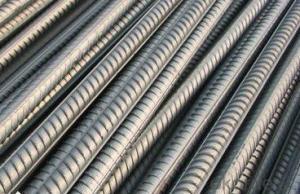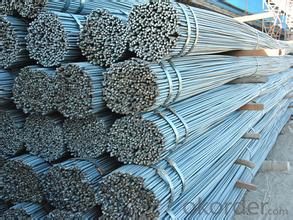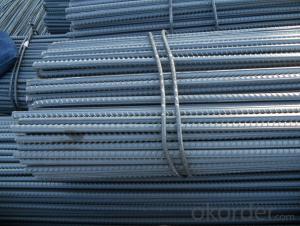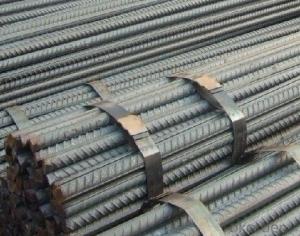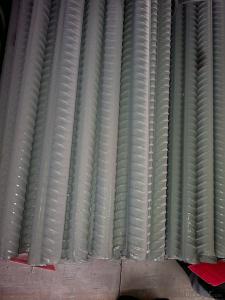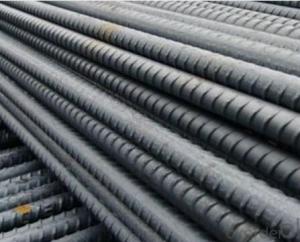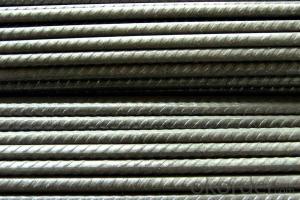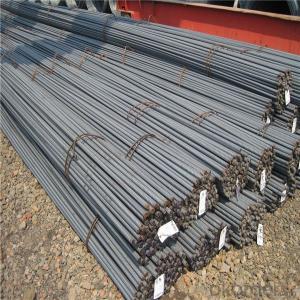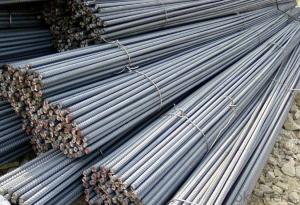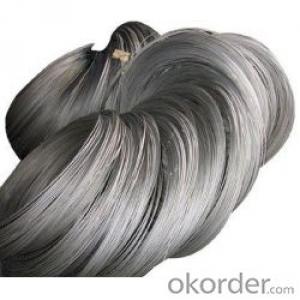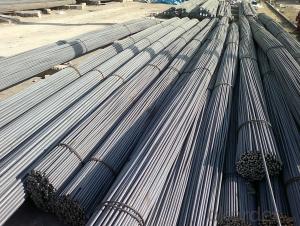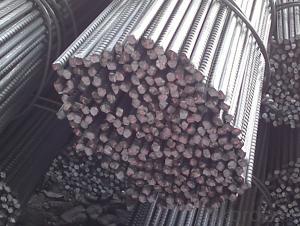Building Material Hot Rolling Bar Rebar Coil 6mm-10mm
- Loading Port:
- Tianjin
- Payment Terms:
- TT OR LC
- Min Order Qty:
- 300 m.t.
- Supply Capability:
- 1500 m.t./month
OKorder Service Pledge
OKorder Financial Service
You Might Also Like
Building Material Hot Rolling Bar Rebar Coil 6mm-10mm
Main Structure of Rolling Bar
Standard: AISI, ASTM, BS, DIN, GB
Grade: HRB400
Diameter: 6mm-10mm
Length: 1.6-1.9ton/coil
Application: for construction
rebar coil size: 6mm-10mm
steel grade: hrb400 , hrb500, gr.60 , hrb335,q235 q255 q275
Description for Rolling Bar
Type | Coiled reinforced bar/rebar coil |
Steel Grade | hrb500, gr.60 ,q235 ,q255,q275 |
Size | 6mm-10mm |
Unit weight | 1.6-1.9tons/coil |
Application | Building/project construction |
Packing | In coil with steel strip ,in bulk . |
Content | C% | Mn% | Si% | Cr% | Ni% | S% | P% | Cr% |
HRB400 | 0.14-0.22 | 0.40-0.65 | 0.05-0.15 | 0.30max | 0.30max | 0.050 | 0.040 | 0.30min |
HRB400E | 0.14-0.22 | 0.40-0.65 | 0.15-0.30 | 0.30max | 0.30max | 0.050 | 0.040 | 0.30min |
HRB500 | 0.28-0.37 | 0.50-1.00 | 0.05-0.15 | 0.30max | 0.30max | 0.050 | 0.040 | 0.30min |
HRB500E | 0.28-0.37 | 0.50-1.00 | 0.15-0.30 | 0.30max | 0.30max | 0.050 | 0.040 | 0.30min |
FAQ
WHY SHOULD YOU CHOOSE US:
Stable quality ----continous casting hot rolled production techenic, strictly quality control system.
Lower price -------Not the cheapest but the lowest price at the same quality .
Good service -----Satisfactory service within 24hours.
Delivery time ------15-25days for the mass production .
Discount---------------discount base on monthly large quantity purchase in long term
Picture:
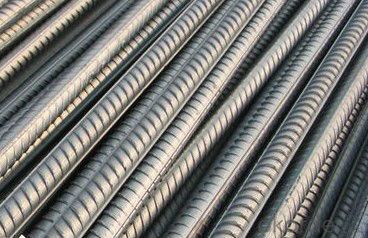
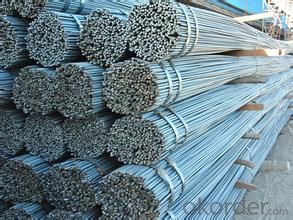
- Q: How are steel rebars protected during transportation and storage?
- Steel rebars are protected during transportation and storage through various measures such as stacking them on pallets or racks to prevent contact with the ground, using protective coverings or tarps to shield them from moisture and environmental elements, and securing them with straps or bands to prevent shifting or damage.
- Q: How do steel rebars contribute to the overall stability of a structure?
- Steel rebars contribute to the overall stability of a structure by enhancing its strength and durability. These reinforcing bars are embedded within concrete to provide tensile strength, which is necessary to resist bending or cracking forces. They help distribute the applied loads evenly throughout the structure, preventing the formation of cracks and ensuring structural integrity. Additionally, rebars help prevent the structure from collapsing under extreme conditions, such as earthquakes or heavy winds, by increasing its ability to withstand these external forces.
- Q: What is the maximum diameter of steel rebars available in the market?
- The maximum diameter of steel rebars available in the market typically ranges from 40 to 50 millimeters.
- Q: What are the guidelines for protecting steel rebars during concrete pouring?
- Some guidelines for protecting steel rebars during concrete pouring include ensuring proper placement and alignment of rebars, using plastic or epoxy-coated rebars to prevent corrosion, providing adequate concrete cover over the rebars, using protective caps on exposed ends, and avoiding over-vibration of the concrete to prevent rebars from shifting. Additionally, it is important to protect rebars from moisture and contamination during storage and construction, and to follow industry standards and specifications for reinforcement placement and protection.
- Q: How do steel rebars contribute to the stability of a structure?
- Steel rebars contribute to the stability of a structure by providing additional strength and support to the concrete. They help to reinforce and enhance the tensile strength of the concrete, making it more resistant to bending, cracking, and structural failure. This reinforcement ensures that the structure can withstand various external forces, such as wind, seismic activity, and heavy loads, improving its overall stability and durability.
- Q: Are steel rebars suitable for use in hospital construction?
- Indeed, steel rebars are a suitable option for hospital construction. Referred to as reinforcing bars, steel rebars are commonly utilized in construction projects to impart strength and stability to concrete structures. In the context of hospital construction, where safety and durability are of utmost importance, steel rebars offer numerous benefits. First and foremost, steel rebars possess remarkable tensile strength, enabling them to endure heavy loads and resist deformation. This attribute is critical in hospital construction, where the edifice must support the weight of medical equipment, patients, and other infrastructure. Furthermore, steel rebars bolster the overall structural integrity of the hospital, guaranteeing long-term stability and safety. Moreover, steel rebars exhibit excellent fire resistance properties. Hospitals are classified as high-risk establishments, as they house potentially flammable materials and electrical equipment. Steel rebars can endure high temperatures without compromising their strength, thus enhancing the structure's fire protection. Additionally, steel rebars are resistant to corrosion, shielding the concrete from damage caused by moisture and chemicals. Hospitals often experience elevated humidity levels and exposure to various chemicals employed in medical procedures. Through the utilization of steel rebars, the risk of corrosion and subsequent structural deterioration is minimized, ensuring a prolonged lifespan for the hospital building. Lastly, steel rebars are easily obtainable and cost-effective. Hospital construction projects frequently adhere to strict timelines, and the use of steel rebars enables efficient construction and swift installation. Furthermore, the market's abundance of steel rebars ensures competitive pricing, rendering them a cost-effective choice for hospital construction. In conclusion, steel rebars are unquestionably suitable for employment in hospital construction. Their high tensile strength, fire resistance, corrosion resistance, and cost-effectiveness render them an ideal selection for guaranteeing the safety, durability, and long-term stability of hospital structures.
- Q: How do steel rebars affect the shrinkage and creep of concrete?
- Steel rebars play a significant role in mitigating the shrinkage and creep of concrete. The presence of rebars helps to improve the tensile strength of concrete, which reduces the occurrence of cracking and shrinkage. By providing reinforcement, steel rebars restrict the movement of concrete, minimizing the risk of shrinkage and creep over time.
- Q: Can steel rebars be used in structures with extreme temperature variations?
- Steel rebars can generally be used in structures with extreme temperature variations. Steel has a high melting point and is known for its durability and strength, making it suitable for various construction applications. However, it is important to consider a few factors when using steel rebars in such structures. Firstly, steel has a coefficient of thermal expansion, which means it expands and contracts with temperature changes. This expansion and contraction can potentially cause stress and strain on the structure if not properly accounted for. To address this issue, engineers and architects use various design techniques, such as providing expansion joints or allowing for thermal movement, to accommodate the steel's thermal expansion and prevent damage. Secondly, extreme temperature variations can affect the mechanical properties of steel. When exposed to high temperatures, steel can lose its strength and stiffness, which might compromise the structural integrity. Conversely, low temperatures can lead to embrittlement, making the steel more susceptible to cracking or fracturing. Therefore, it is crucial to choose the appropriate grade and quality of steel rebars that are specifically designed to withstand the expected temperature variations. Furthermore, the type of structure and its intended use should be considered. For instance, in structures where extreme temperature variations are anticipated, such as bridges or buildings in regions with hot summers and cold winters, the design should incorporate thermal insulation or other measures to prevent excessive heat transfer or thermal stress accumulation. In conclusion, steel rebars can be used in structures with extreme temperature variations, but proper considerations must be taken. By accounting for thermal expansion, selecting suitable steel grades, and incorporating design techniques to accommodate temperature changes, the structural integrity and performance can be maintained, ensuring the safety and longevity of the construction.
- Q: Are steel rebars suitable for use in high-rise buildings?
- Yes, steel rebars are suitable for use in high-rise buildings. Steel rebars provide excellent strength, durability, and flexibility, making them ideal for reinforcing concrete structures in high-rise buildings. Their ability to resist tensile forces and bond with concrete ensures the structural integrity and stability required in tall buildings.
- Q: Are steel rebars suitable for earthquake-resistant structures?
- Yes, steel rebars are suitable for earthquake-resistant structures. Steel rebars provide excellent tensile strength and reinforcement to concrete structures, making them more resistant to the lateral forces and vibrations caused by earthquakes. They help to distribute and absorb the energy generated during seismic events, enhancing the overall structural integrity and reducing the risk of collapse. Steel rebars have been widely used in earthquake-prone areas and are considered a reliable choice for ensuring the safety and stability of buildings and infrastructure during earthquakes.
Send your message to us
Building Material Hot Rolling Bar Rebar Coil 6mm-10mm
- Loading Port:
- Tianjin
- Payment Terms:
- TT OR LC
- Min Order Qty:
- 300 m.t.
- Supply Capability:
- 1500 m.t./month
OKorder Service Pledge
OKorder Financial Service
Similar products
Hot products
Hot Searches
Related keywords
